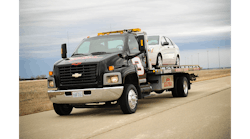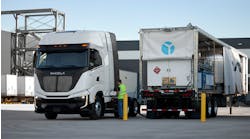The ever-shrinking pool of experienced commercial vehicle operators has had a considerable impact on how medium duty fleets make purchasing decisions today. In order to maximize their returns on investments in vehicles, these fleets must consider a number of factors, including, but not limited to, training, maintenance and fuel consumption.
Today, medium duty fleets of all types and sizes are forced to cope with the reality that fewer and fewer drivers are capable of operating vehicles equipped with manual transmissions. According to Larry Love, executive director, global marketing, Allison Transmission – a manufacturer of fully automatic transmissions for medium and heavy duty commercial vehicles (www.allisontransmission.com) – these fleets are also finding automatic transmissions are easier and less costly to maintain, resulting in a lower lifetime cost as well as improved vehicle uptime.
Furthermore, according to Alison Thomas, product strategy manager, Eaton – a diversified industrial products manufacturer in the fluid power, industrial and commercial controls, automotive and truck industries (www.eaton.com) – automation rates in North America have increased from about 70 percent to 95 percent in the past 10 years.
“The trend toward automation in medium duty markets is a function of vehicles being ‘a tool’ used to perform a task,” says Thomas. “In contrast to Class 8 operations, where the vehicle tends to be the business, and driving the vehicle is the operator’s primary responsibility, medium duty truck drivers wear more hats and act as drivers, salespeople, order takers, shelf stockers and more.”
PERFORMANCE AND MAINTENANCE CONSIDERATIONS
Both manual and automatic transmissions require a clutch pedal to connect to the vehicle’s engine. During gear changes, engine torque is interrupted and the vehicle begins to lose speed. As a result, more fuel is needed to be consumed for the vehicle to maintain a certain speed.
When speed is lost at each gear change, it translates into a lower average speed for the vehicle over the course of a workday. Performance is negatively affected, as is the fleet’s bottom line.
Also, the clutch of a manual transmission or automated manual transmission (AMT) is a wear item that requires regular inspection, maintenance and replacement at certain intervals. Maintenance of the clutch can be quite frequent due to the potential abuse it takes from inexperienced vehicle operators.
Furthermore, driver fatigue from constant use of the clutch pedal and gear shifter is a significant and unwelcomed byproduct of operating manual-equipped vehicles.
“Manuals remain a proven, cost-effective option for fleets with skilled drivers,” says Thomas of Eaton. “Automatic transmissions offer a more comfortable driving experience, particularly for less skilled drivers.”
SPEC’ING
When spec’ing vehicles, medium duty fleets need to ask a number of questions related to automatic and manual transmissions, says Allison’s Love. These include:
- Does my fleet value reliability and durability, performance or fuel economy, and to what degree?
- Does my fleet value driver comfort and driver retention, or seek a higher level of safety?
- What type of fuel will my fleet use, and what is the appropriate transmission choice to maximize vehicle performance for that fuel choice?
Eaton’s Thomas also points to four key factors for medium duty fleets to consider when evaluating vehicles equipped with manual transmissions versus vehicles equipped with automatic transmissions:
- Application -- Primarily whether or not a vehicle will require a power take-off (PTO). Many medium duty fleets will spec a transmission with a PTO purely for the enhanced residual value of the vehicle.
- Terrain -- The geography where a medium duty vehicle will be used can influence a truck’s torque and horsepower requirements. Vehicles that are used in hilly or mountainous areas often require higher ratings.
- Fleet preferences for acceleration performance, balanced against the preference for fuel economy.
- How long does the fleet intend to keep the vehicle? -- Many lease fleets turn vehicles over every five years or so, with the goal of maintaining “nice” and new vehicles that are more consumer-friendly. Conversely, small businesses may keep trucks for 15 to 20 years or longer, or at least up until repairs become costly enough to warrant replacing them. School busses have an average life of 12 to 15 years, and some states require them to be retired upon reaching a designated vehicle age.
ADDITIONAL CONSIDERATIONS
The quest for improved fuel economy and the emergence of alternative fuels have been key drivers for medium duty fleets as they transition toward vehicles equipped with automatic transitions. Now, more than ever before, medium duty fleets should be focused on the performance of their vehicles and how transmissions in them are affecting that performance.
“We’ve seen the vast majority of the medium duty market convert to automatic transmissions, leaving only a handful of manual or automated manual transmissions,” says Love of Allison.
“This trend is particularly evidenced in school bus applications, which have seen a significant shift toward the use of propane engines in recent years,” adds Thomas of Eaton. “Much of the shift toward alternative fuels is attributed to the increasing cost and complexity of diesel emissions technology, such as diesel particulate filter systems.”
Examples of transmission technology designed to improve fuel economy include “smart shift” schedule adjustments, deeper and enhanced engine/transmission optimization and integration, as well as vehicle acceleration management.
TRENDING TOWARD AUTOMATION
Every medium duty fleet is different. So when spec’ing vehicles, these fleets need to keep a number of considerations in mind when deciding between vehicles equipped with manual transmissions or vehicles equipped with automatic transmissions. However, a combination of factors – including the ever-shrinking pool of experienced drivers, resources and capital available for training – as well as a concerted effort to improve fuel economy, have led many medium duty fleets to lean toward automation.
“Initial cost is lower for the manual over the automatic, however, when total lifetime costs of training, maintenance, fuel consumption and productivity are factored in, the automatic is the lower overall cost choice,” says Love.




